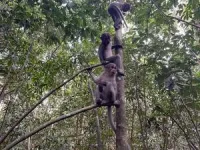(Press-News.org) CORVALLIS, Ore. – Forest thinning is improving the robustness of older trees and enhancing native biodiversity on federal lands in eastern Oregon, evidence that collaborative efforts to restore forests are working, research by Oregon State University shows.
The study led by James Johnston of the OSU College of Forestry involved long-term monitoring and research partnerships between OSU, the U.S. Forest Service and local groups in Oregon’s Blue Mountains.
Published today in Forest Ecology and Management, the findings illustrate the collaboration’s success in “securing federal investment and delivering science products that measure forest treatments’ effectiveness,” Johnston said.
“Ecological restoration of seasonally dry, fire-prone forests has been a key goal of Forest Service managers for more than two decades,” he said. “Our study shows that thinning aids in bringing back tree and understory vegetation conditions associated with the ability to bounce back in the face of disturbance. And thinning doesn’t just help managers mitigate fire risk – it restores a range of ecological functions that over time make forests more resilient.”
Johnston and researchers with the Forest Service, Blue Mountains Forest Partners and the Nature Conservancy looked at a 2,900-hectare area in the Malheur National Forest. The ponderosa pine forests of the southern Blue Mountains are a “priority landscape” that receives federal funding under the Forest Service’s Collaborative Forest Landscape Restoration Program.
In 2014 and 2015, the study area was thinned in an effort to increase resilience to fire while facilitating the return of episodic low-severity fire, Johnson said. Fire dynamics in the area, and throughout seasonally dry forests of the interior Pacific Northwest, changed drastically starting in the last decades of the 19th century, he noted.
“The late 1800s and early 1900s were unusually cool and moist,” he said. “On top of that, European settlement changed how Indigenous people used fire on the landscape – i.e., the settlers did not want fire on the land, and early forest rangers aggressively extinguished fire starts in the name of sustained yield timber harvest. Also, there was extensive unregulated grazing that removed the fuel that carried low-severity surface fire.”
By the late 20th century, dense stands and shaded understories were resulting in high-severity wildfire, uncharacteristically severe drought-related mortality and susceptibility to bark beetles. Generally speaking, the forests were no longer nearly as resilient as they were when they had consisted of open stands of widely spaced, shade-intolerant, fire-resistant trees.
In this study, Johnston and collaborators quantified the degree to which thinning can restore resilience by analyzing overstory tree attributes such as radial growth, resin production, abundance of non-structural carbohydrates and leaf area; all of those are associated with resilience.
“We also investigated the responses of understory vegetation – the grasses, forbs and shrubs that influence fire behavior and forest resilience,” he said. “We saw an increase in species richness and diversity within thinned stands three to four years after thinning, which stimulated the growth of vegetation that supports low-intensity fire regimes and is suppressed under a closed-canopy forest.”
The scientists found that tree radial growth was greater in thinned stands beginning three years after thinning, and the abundance of glucose and fructose was lower in treated stands, suggesting trees were using carbon reserves for leaf and wood production.
“And while our study area was not treated with prescribed fire, we see the reintroduction of fire as an important management tool that can restore historical fire regimes and achieve additional management goals,” Johnston said.
Funding for this study was provided by the Forest Service through the Collaborative Forest Landscape Restoration Program and by the Blue Mountain Forest Partners.
END
Efforts to restore federal forests in eastern Oregon are working, Oregon State research shows
2023-09-06
ELSE PRESS RELEASES FROM THIS DATE:
Global surge in cancers among the under 50s over past three decades
2023-09-06
There’s been a striking 79% increase in new cases of cancer among the under 50s around the world over the past three decades (1990-2019), finds research published today in the open access journal BMJ Oncology.
Breast cancer accounted for the highest number of ‘early onset’ cases in this age group in 2019. But cancers of the windpipe (nasopharynx) and prostate have risen the fastest since 1990, the analysis reveals. Cancers exacting the heaviest death toll and compromising health the most among younger adults in 2019 were those of the breast, windpipe, lung, bowel, and stomach.
The findings ...
Strong evidence of ‘threshold effect’ for NHS 18-week waiting list target
2023-09-06
There’s strong evidence of a ‘threshold effect’ in English hospitals’ efforts to comply with the 18-week referral to treatment standard, concludes a long term data analysis of performance against the target, published online in the journal BMJ Quality & Safety.
The target focused activity on meeting the threshold requirement for patients on the waiting list after which it tailed off—the so-called threshold effect–rather than instigating pervasive improvement in practice, the analysis indicates. Clinical need may be a secondary consideration for meeting the target, suggest the researchers.
In 2012, an 18-week ...
Hyperactivity disorder (ADHD) risk factor for serious mental health issues
2023-09-06
The hyperactivity disorder, usually referred to as ADHD, is an independent risk factor for several common and serious mental health issues, finds research published in the open access journal BMJ Mental Health.
It is associated with major depression, post traumatic stress disorder, the eating disorder anorexia nervosa, and suicide attempts, the findings show, prompting the researchers to recommend vigilance by health professionals in a bid to ward off these disorders later on.
Attention-deficit/hyperactivity disorder (ADHD) is a neurodevelopmental condition in children and teens that extends into adulthood in up to around two thirds of cases. Worldwide, its prevalence ...
Human shoulders and elbows first evolved as brakes for climbing apes
2023-09-06
The rotating shoulders and extending elbows that allow humans to reach for a high shelf or toss a ball with friends may have first evolved as a natural braking system for our primate ancestors who simply needed to get out of trees without dying.
Dartmouth researchers report in the journal Royal Society Open Science that apes and early humans likely evolved free-moving shoulders and flexible elbows to slow their descent from trees as gravity pulled on their heavier bodies. When early humans left forests for the grassy savanna, the researchers say, their versatile appendages were essential ...
The limestone spheroids of ‘Ubeidiya: Intentional imposition of symmetric geometry by early hominins?
2023-09-06
Limestone spheroids, enigmatic lithic artifacts from the ancient past, have perplexed archaeologists for years. While they span from the Oldowan to the Middle Palaeolithic, the purpose behind their creation remains a subject of intense debate. Now, a study conducted by a team from the Computational Archaeology Laboratory of the Hebrew University of Jerusalem, in collaboration with researchers from Tel Hai College and Rovira i Virgili University seeks to shed light on these mysterious objects, offering insights into the intentions and skills of early hominins.
Spheroids ...
Balancing biodiversity, climate change, food for a trifecta
2023-09-06
Across the globe, and particularly in Brazil, lies an embarrassment of riches that also stage a showdown as mitigating climate change and protecting biodiversity square off against growing food.
In this week’s Science of the Total Environment, scientists from and once affiliated with Michigan State University’s Center for Systems Integration and Sustainability (MSU-CSIS) identify ways for landowners in rural areas to be able to capitalize on win-win situations, whether they have fruitful land ...
COVID-19 vaccination appears safe in study of patients with glomerular diseases
2023-09-05
Among 2,055 adults with a wide range of glomerular diseases, the COVID-19 vaccination did not adversely affect kidney function or worsen kidney damage and appeared safe in this population.
Patients with glomerular disease (GN) may be at increased risk of severe COVID-19, yet concerns over vaccines causing disease relapse may lead to vaccine hesitancy. Researchers examined the associations of COVID-19 with longitudinal kidney function and proteinuria and compared these to similar associations with COVID-19 vaccination. In this cohort study of 2,055 patients with minimal change disease (MCD), focal segmental glomerulosclerosis (FSGS), membranous nephropathy, or ...
Study: Health equity an important aspect of improving quality of care provided to children in emergency departments
2023-09-05
INDIANAPOLIS—A new multi-site study led by Indiana University School of Medicine found increasing pediatric readiness in emergency departments reduces, but does not eliminate, racial and ethnic disparities in children and adolescents with acute medical emergencies.
The study also involved researchers from Oregon Health and Science University and UC Davis Health. They recently published their findings in JAMA Open Network.
“Ours is a national study group focused on pediatric emergency department readiness,” said Peter Jenkins, MD, associate professor surgery at IU School of Medicine and first ...
UMass Amherst researcher shines light on effectiveness of school sunscreen legislation
2023-09-05
AMHERST, Mass. – States that enacted laws permitting children to carry and apply sunscreen at school experienced an increased interest in sun protection and a higher rate of sunscreen use among adolescents, according to new research by a University of Massachusetts Amherst resource economist.
Brandyn Churchill, assistant professor of resource economics at UMass Amherst, is co-author of the study that is the first to examine state-level “SUNucate” laws, which permit students to apply sunscreen at school and wear sun-protective clothing even if it does not ...
Fossil spines reveal deep sea’s past
2023-09-05
Right at the bottom of the deep sea, the first very simple forms of life on earth probably emerged a long time ago. Today, the deep sea is known for its bizarre fauna. Intensive research is being conducted into how the number of species living on the sea floor have changed in the meantime. Some theories say that the ecosystems of the deep sea have emerged again and again after multiple mass extinctions and oceanic upheavals. Today's life in the deep sea would thus be comparatively young in the history of the Earth. But there is increasing evidence that parts of this world are much older than previously thought. A research team led by the University ...






